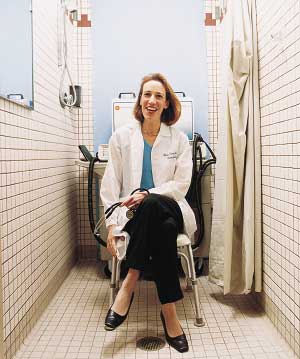The expression "translational medicine" sums up Stanford University Medical Center's top priority: translating the insights of students, clinicians and scientists into practical advances that enhance and prolong life.
 |
|
Alexa Kimball, MD, MPH, in a treatment booth for a cancer therapy she's testing. |
|
It takes patients
Clinical trials researchers straddle worlds of research and patient care
By Linley Erin Hall
Photographs Bryce Duffy
Many physicians at Stanford Hospital & Clinics and Lucile Packard Children's Hospital conduct clinical trials. But a few, like Mark Genovese, MD, assistant professor of medicine, and Alexa Boer Kimball, MD, MPH, assistant professor of dermatology, make it their life's work Kimball and Genovese are among a small but growing number of physicians at academic medical centers who devote themselves to testing the safety and efficacy of treatments. Though during the past decade clinical trials have most often been carried out by commercial research organizations, leading academic medical centers like Stanford have begun to make them a priority. With Stanford's focus on turning research findings into medical advances, this makes a lot of sense.
Kimball heads the Clinical Trial Center in Stanford's dermatology department. Her mission, when she joined the department in 2000 was to expand the center. Genovese directs clinical trials interventions for Stanford's division of immunology and rheumatology. Both evaluate, select, conduct and analyze clinical trials.
As clinical trial specialists, they have one foot in the research laboratory and another in the clinic. They perform statistical analyses, keep abreast of changes in regulations and teach other doctors how to run clinical trials. And of course, they take care of patients. Kimball likes variety, so this is an ideal job for her. "You do different things all day long, and it's so great to see patients improve," she says.
Kimball spent part of her Stanford dermatology residency working at the National Institutes of Health. Based on that experience, she decided not to pursue a traditional lab-based fellowship. Instead, she began working on several NIH clinical trials. While there, she earned a master's degree in public health at Johns Hopkins University, focusing her studies on clinical trial design and regulatory issues. In 2000 Kimball returned to Stanford to head dermatology's clinical trial center.
"It's a big misconception that anyone can do clinical trials," Kimball says. "You really need lots of training."
 |
|
Mark Genovese, MD, clinical trials specialist. |
|
Genovese's interest in clinical trials emerged in medical school. After completing his residency, chief residency and postdoctoral fellowship at Stanford, he joined the faculty and became immersed in clinical trials.
"I get to see interesting science going on in other parts of the division and see how those innovations can improve patients' lives," Genovese says. He selects and conducts trials for treatments of many different autoimmune diseases, including rheumatoid arthritis, systemic sclerosis and lupus.
Stanford's clinical trials specialists have plenty of trials to choose from. Some of the therapies they test come out of Stanford labs or NIH collaborations; others originate from pharmaceutical companies large and small.
It's typical for Genovese to be running up to a dozen open trials -- ones in which patients are actively receiving treatment -- and to be recruiting patients for two to four more. Kimball's 10 open dermatology trials range from cosmetic procedures to treatments for serious skin diseases. These trials may be the first test of a drug in humans or a large, multicenter trial of a pharmaceutical clearing the last hurdle to approval by the Food and Drug Administration.
About half of Kimball's studies are preset, FDA-approved protocols intended to be uniform across up to 30 sites. These studies are great for teaching, Kimball says, because FDA standards are extremely rigorous. But both researchers prefer to conduct trials they can have a hand in designing. Sometimes a pharmaceutical company presents several possible trial protocols and asks for help in selecting the best. Other times Kimball or Genovese will design a protocol for a company or will enter one in an NIH clinical trials grant competition.
Genovese looks at many factors when deciding whether to get involved in a trial. First, he considers if "reasonable science" backs up the proposed trial. Is the therapy valid? Is the basic science well-founded? Have the animal studies been conducted well? Does the work at the lab bench have applicability to the bedside?
Then he looks at patient issues. Is this a rational study for patients? Does the study ask the right questions of patients? Does the study put patients at undue risk?
Finally, Genovese considers the cost of the trial and the likelihood that it will yield useful results. If all these questions receive favorable answers, he will probably decide to conduct the trial.
Genovese seeks input from his colleagues to answer these questions, for they might know of potential problems or similar studies. He also asks his research assistants what they think; they can provide feedback on whether the local patient population fits the trial's requirements, for example.
"With the advances that have come, it is more difficult to recruit patients to participate in studies," Genovese says. "People are happier with the drugs they're already on."
"It's easy to recruit for acne and wrinkle studies. Disease studies are much harder," Kimball concurs.
Kimball and Genovese find patients with help from support and advocacy groups such as the Arthritis Foundation and the Bay Area Scleroderma Support Group. They also ask physicians for referrals. Ads in local newspapers or on the radio make up a small portion of the recruitment effort.
Few Drugs Make the Cut
Most trials last months or even years, although in Kimball's fastest study the patients used the treatment only two weeks. And for each success story, many pharmaceuticals fail. Three of the drugs Genovese has guided through trials are commercially available; 10 have fallen short -- in most cases because, though the medication proved safe, it failed to treat the illness effectively. Kimball has conducted clinical trials at Stanford for only three years, too short a time for drugs she has tested to receive FDA approval -- a process that typically takes seven to 10 years.
An important tool for evaluating the effectiveness of a drug is a placebo -- a pill that looks like the medication but contains none of the active ingredient. Trials in which neither the physician nor the patient knows if the patient is receiving the drug or a placebo are considered the "gold standard." But withholding treatment can be hard on the patient and the physician.
"The part I hate the most is watching patients who are probably on placebo, especially if the drug is really working," Kimball says. "We must have placebo arms in trials. Sometimes the placebo is better if the drug has bad side effects. But that's still hard."
Despite the challenges, Kimball and Genovese enjoy straddling the research and clinical worlds. They know that their work can significantly impact patient lives by improving quality of life, preventing disability and returning function. "At university medical centers, patients come for knowledge and access to the latest therapies. Clinical trials are integral to our mission," Genovese says.
In phase
A drug or other experimental treatment must clear several phases of clinical trials before FDA approval.
phase I:
Humans use the drug for the first time. This trial tests the drug's toxicity and finds an appropriate range of doses. Sometimes researchers can gather preliminary data on how well the drug works.
phase II:
Patients receive the drug in different doses within the range found in phase I. This larger trial gives doctors information about the drug's efficacy, side effects and possibly safe doses.
phase III:
Hundreds or even thousands of patients at several sites around the nation take the drug or a placebo. Phase III is designed to confirm the safety and efficacy of the drug.
Anatomy of a Trial
Every clinical trial follows the same basic steps to ensure patient safety and accuracy of results. This example follows a typical phase-II trial in the Department of Dermatology's Clinical Trial Center headed by Alexa Boer Kimball, MD, MPH, assistant professor of dermatology.
-
A company approaches Stanford about doing a phase-II drug trial.
-
Kimball designs a protocol for the trial, including how researchers will obtain consent from patients, test the drug's efficacy and ensure patient safety.
-
Stanford's Panel on Human Subjects examines the overall risks and benefits of the trial and approves how the trial will be described to patients.
-
Stanford's Office of Sponsored Research looks over the protocol to check for potential conflicts of interest and to protect the rights of Stanford.
-
The FDA checks the trial for safety and assesses whether it can answer the relevant questions.
-
With approvals in hand, Kimball and her staff begin to recruit patients.
-
Kimball screens potential patients using inclusion and exclusion criteria, which may include other drugs used, other health problems, age, etc.
-
Enrolled patients use the drug according to the protocol. They may come in for several clinical visits over the course of the trial. At each visit, the physician records more information than usual. "We record everything, even bike accidents," Kimball says. Why? "If all the patients are getting in accidents, then the medicine may make them sleepy."
-
Kimball's staff gathers the data and analyzes it.
-
Kimball sends the results of the trial, including the efficacy found for the drug and any adverse events that occurred, to the Panel on Human Subjects and the FDA.
-
If the results of the study are worth publishing, Kimball prepares a paper and sends it to an appropriate journal.
Comments? Contact Stanford Medicine at

